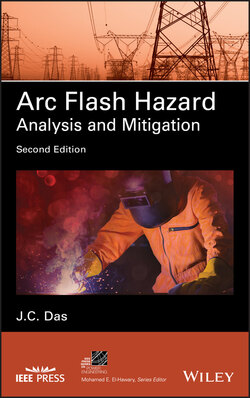Читать книгу Arc Flash Hazard Analysis and Mitigation - J. C. Das - Страница 25
1.7 FIRE HAZARD
ОглавлениеNFPA and National Fire Incident Reporting Systems (NFIRS) statistics of fire hazard can be viewed on websites. These statistics are based upon:
heat source, that is, arcing
contributing factors like electrical failure or malfunction
equipment involved in electrical distribution, lighting, and power transfer.
TABLE 1.3. Time–Current Zones for 15–100 Hz AC Currents for Hand-to-Feet Pathway
Source: Reference [23].
| Zone | Boundaries | Physiological Effects |
| AC-1 | Up to 0.5 mA, curve a | Perception possible but usually no “startled” reaction |
| AC-2 | 0.5 mA up to curve b | Perception and involuntary muscular contractions likely but usually no harmful physiological effects |
| AC-3 | Curve b and above | Strong involuntary muscular contractions, difficulty in breathing. Reversible disturbances of heart function. Immobilization may occur. Effects increasing with current magnitude. Usually no organic damage to be expected. |
| AC-4a | Above curve c1 | Pathophysiological effects may occur, such as cardiac arrest, burns, or other cellular damage. Probability of ventricular fibrillation increasing with current magnitude and time |
| c1–c2 | AC-4.1: Probability of ventricular fibrillation increasing up to about 5% | |
| c2–c3 | AC-4.2: Probability of ventricular fibrillation increasing up to about 50% | |
| Beyond curve c3 | AC-4.3: Probability of ventricular fibrillation increasing above 50% |
a For duration of current flow below 200 ms, ventricular fibrillation is only initiated within the vulnerable period if the relevant thresholds are passed. As regards to ventricular fibrillation, this figure relates to the effects of current which flow in the path from left hand to feet. For other current paths, the heart current factor has to be considered.
In 1999–2003, arcing was the heat source that resulted in 37,700 home fires, 240 deaths, 890 home fire injuries, and $703 million in direct property damage [30, 31].
Fires can develop in electrical equipment due to overloads and loose connections that are not cleared by overcurrent devices. The equipment should be listed by a nationally recognized test laboratory (NRTL), which helps to reduce the fire risk. Some precautionary and design measures are:
Fire detection and suppression equipment should be permanently installed or readily accessible around the electrical equipment. Such equipment could possibly include smoke detectors, sprinkler systems, and portable fire extinguishers.
The workplace should be designed so that escape routes are sufficiently wide, clear of obstructions, well marked and lighted. Normal and emergency lighting and exit signs are important.
Special considerations should be applied to the electrical equipment located in hazardous areas, according to NEC.
All conductors and wiring should be properly sized for protection against overheating (see Article 310 of NEC).
Overcurrent protection should be provided to meet the requirements of NEC.
Motors and generators should be properly protected so that these do not cause a fire hazard.
The transformers should be protected and installed according to NEC, UL, and FM (factory mutual) guidelines. In general, all electrical equipment must be installed, operated, and maintained according to codes and standards (see Chapter 2).
The fire hazards are not further discussed in this book.
